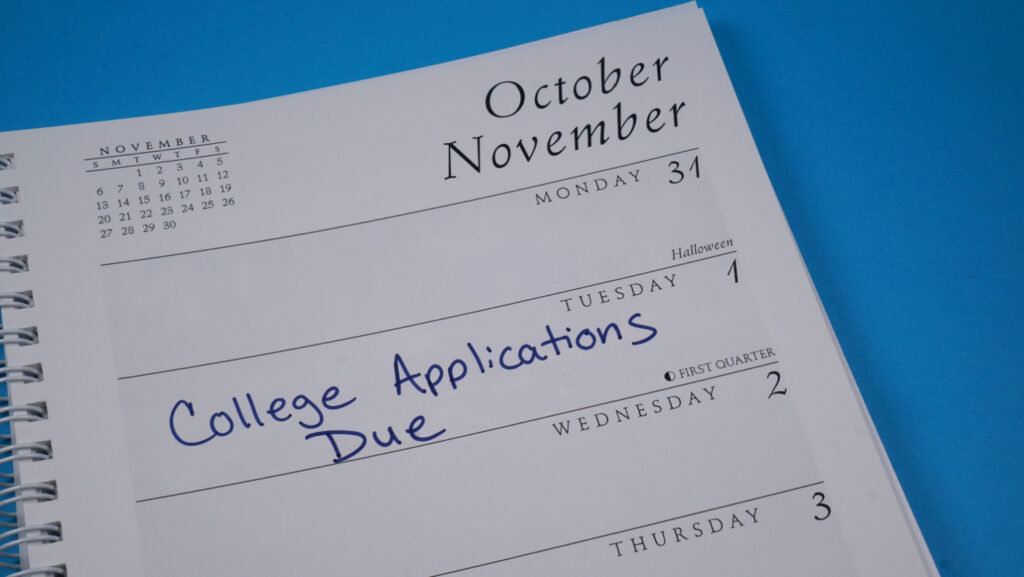
Our calculator isn’t just an algorithm—it’s powered by decades of real-world counseling experience. Below, you’ll see your chances on a color-coded scale indicating:
Far Reach, Reach, Possible, Target, Probable, and Likely. Use it to understand where you stand and build a smart, balanced list of schools.
| LIKELIHOOD | SCHOOL | SELECTIVITY | SAT MATH | SAT R/W | ACT |
|---|

It is critical for students to understand that nothing will improve their admissions probabilities more than earning stellar grades and raising their SAT/ACT scores.
Your top priority should be achieving stellar grades in the most rigorous courses where you can succeed. While many schools now offer test-optional admissions, you won’t find any schools that are “grade-optional.” Even with the aforementioned policies, practicing for the SAT and ACT remains highly valuable and can provide a meaningful edge in the admissions process.
At highly-selective institutions in particular, competitive grades in a rigorous curriculum and excellent standardized test scores are necessary, but not alone sufficient for admission. Actions like enhancing one’s extracurricular profile, penning memorable essays, and securing strong teacher recommendations are also important.
To a lesser extent, factors like work experience, first-generation status, character/personal qualities, and level of demonstrated interest can also move the admissions dial to some degree.
Never forget that your safety schools should have many of the same attributes and programmatic offerings as your target and reach schools. You should spend as much time researching, contacting, and visiting your safety schools as you do with your top choices.
You’ll also want to make sure that you apply to one “financial safety school,” where you and your family are comfortable covering 100% of the full cost of attendance. This means that you have a plan to cover the cost, even if it means taking out low-interest loans.
Articles and other pages related to college acceptance.

A great sculptor stares at a giant hunk of stone and can visualize, in their mind’s eye, a finished work of art; the average person just sees a rock. When it comes to the task of creating a list of prospective colleges, most teens and their parents are intimidated…

In the early 1990s, the University of Pennsylvania was struggling to keep up with its fellow Ivy League universities and found itself frequently relegated to “backup plan” status among the nation’s top students. Their institution’s location in less-than-idyllic West Philadelphia…

As the calendar turns to April, Emily, a high school senior and aspiring engineering student on the East Coast with phenomenal test scores (1530 SAT) and near-perfect grades (in mostly AP courses), begins to hear back from her prospective colleges. First, she receives…
Building an accurate tool for estimating one’s chances of acceptance is more than just an algorithm. Rather it is the combination data-driven scientific formula PLUS the art of having counseled thousands of students into Ivy League and other highly-selective universities.
Our massive trove of student-level admission outcomes data along with our understanding of the trends and nuances of the admissions space translates to a more meaningful user experience for you.
Using our collective expertise and experience, we constructed this calculator to give accurate weight to factors including (but not limited to):
A college admissions calculator can help you determine the probability of you gaining admissions to schools by offering a percentage range of your individual chances as follows:
By helping you to categorize your prospective colleges by probability of admission, you will be able to craft a balanced and healthy college list that maximizes your chances for a successful outcome.
No college calculator in the world can tell you with any validity that you have a 62.8% chance to get into Stanford University. Why not? Simply put, schools with sub-5% acceptance rates reject many students with 1600 SAT scores, 4.0 GPAs, and jaw-dropping extracurricular achievements.
There is a difference between the appearance of accuracy (a precise percentage) and true honest accuracy which can only be represented by a range of probability. Another company’s admissions calculator may promise what looks like superior precision, but is in fact delivering a less accurate and helpful prediction.
Myth #1: The acceptance rate at a given school is my percentage chance of getting in.
Fact: The overall admission rate listed is simply the applicants accepted at that school divided by the number of total applicants. Where you fit into that applicant pool is more important than the straightforward percentage.
Myth #2: Every applicant is viewed equally by admissions officers.
Fact: Factors such as geographic location, ability to pay full tuition, the high school you attend, athletic recruitment, first-generation status, and legacy status are just some of the many consideration for admissions officers when constructing a class. A first-generation volleyball star from Montana will be viewed differently than a cellist attending a private school in Massachusetts.
Myth #3: Every factor can be quantifiably measured and factored into an acceptance rate.
Fact: At highly competitive colleges, supplemental essays, interviews, and portfolios may be tiebreakers among applicants who possess the necessary academic credentials to earn acceptance. It is simply not possible to include these factors in an admissions calculator.
Share your results with family, counselors, and other collaborators.